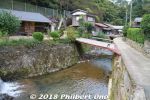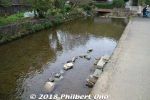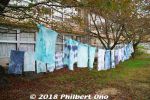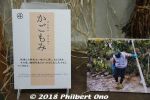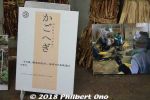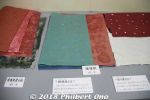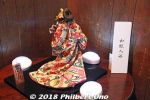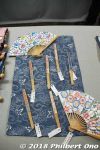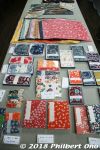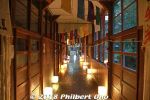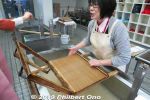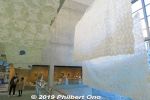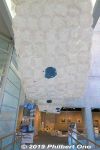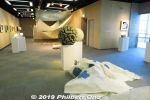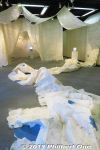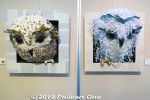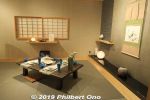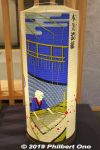 Image search results - "washi" Image search results - "washi" |
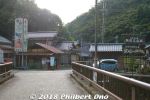
Kurotani is the name of the village (now part of Ayabe city) where they make Kurotani washi paper. This is the entrance to the small village in a valley.Kurotani Village started making washi about 800 years ago when 16 warriors of the Heike Clan defeated by the Minamoto Clan in Kyoto (Genpei War 1180–1185) fled and hid here to avoid capture. They and the local farmers made a living in summer by growing rice, but since there was nothing to do in winter, they thought of making washi paper. Washi can only be made in winter since it requires cold water.
|
|
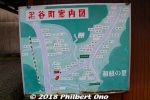
Kurotani Washi-no-Sato Japanese papermaking village in Ayabe, Kyoto.Once upon a time, there were a number of washi paper makers in northern Kyoto like Tango washi and Tanba washi, but now there's only one traditional maker that has survived called Kurotani washi. They work here in the small Kurotani Valley.
|
|
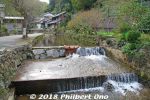
Kurotani village was blessed with this clean Kurotani River, essential for papermaking. Kurotani washi is quite famous now, even overseas.
|
|
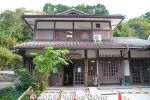
Kurotani village has this Kurotani Washi Kaikan gift shop (黒谷和紙会館). Kurotani is not touristy because it's not convenient to get here.
|
|
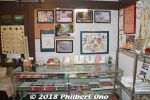
Inside Kurotani Washi Kaikan gift shop.
|
|
|
|
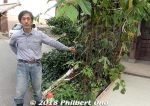
Kurotani washi mainly uses kozo or mitsumata mulberry plants as the raw material. This is our Kurotani washi guide showing us the kozo plants that can grow to three meters high.They are harvested in autumn by cutting the trunks or branches. They grow kozo mulberry near Ayabe Station. Kozo is called "kago" in Kurotani.
|
|
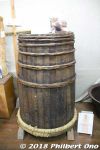
To make the paper fibers for washi, there are many laborious steps. After the kozo branches are cut in even lengths, they are stuffed in a barrel (koshiki) like this and placed over a boiling and steaming iron pot for three to four hours to soften the brown bark.
|
|
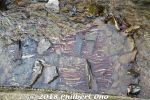
While the kozo branches are still hot, elderly ladies twist and strip off the brown bark (kuro-kawa 黒皮). The bark is dried, then soaked in river water like here.
|
|
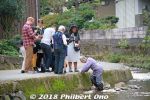
While soaking, the kozo bark is also kneaded by human feet to soften it. The water is cold, and it's a traditional job for the grandmas.
|
|
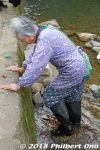
We just happened to come across her in the river kneadking the brown bark. How lucky we were.
|
|
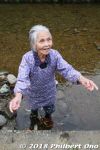
She's Horie Sayo, 86 years old, been doing it since her teens.
|
|
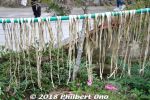
The brown kozo bark is shaved and scraped with a knife by hand to remove the brown bark skin and other blemishes. Then the becomes thin, white strips that are dried in the sun. (shiro-kawa 白皮)
|
|
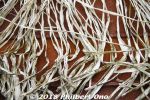
White kozo bark strips drying. These will then be mashed and beaten into fibrous globs. Preparing the kozo fibers from the bark is the most laborious and time-consuming part of washi making.
|
|
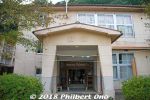
Also visited Kurotani Washi Kougei No Sato (Kurotani Washi Craft Village 黒谷和紙 工芸の里) a 20-min. car ride away.They were using an old elementary school.
|
|
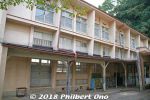
They use the 1st floor for making paper, while the second floor are washi exhibition rooms.
|
|
|
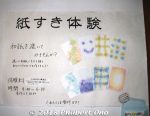
They offer washi papermaking lessons for ¥1,300 including admission.
|
|
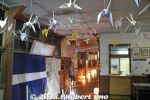
Entrance hall with origami cranes made of Kurotani washi. It really looks like an old school.
|
|
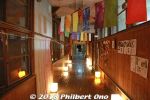
Corridor to rooms.
|
|
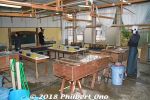
Washi papermaking room where we tried making Kurotani washi paper (postcards).
|
|
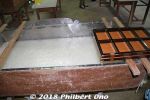
A large vat (sukifune) filled with washi fibers floating evenly in the water. The fibers are mixed in with a plant-based adhesive so they don't sink to the bottom and they also cling together to make the paper. A wooden mold (keta 桁) to make eight postcards on the right. Kurotani washi bills itself as Japan's strongest paper. In the 1920s, Kurotani washi was tested for strength and was declared the strongest washi in Japan. I was told Kurotani's kozo has longer fibers than other species so the paper is stronger.
|
|
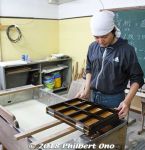
Our instructor first showed us how it was done. He used a mold to make eight washi postcards.
|
|

About sugeta.
|
|
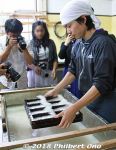
Dump the postcard mold into the vat and swish it left/right and forward/back evenly.
|
|

Takes three years to learn how to make washi paper with a mold. Ten years to become an expert. But we did it in a minute or two... Just dip the mold into the fibrous water, and swish it to the left/right and forward/back.
|
|

The postcards looked quite thick out of the mold, but they would get much thinner when dried.
|
|
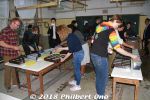
Afterward, we could decorate our postcards with colored ink/fibers.
|
|
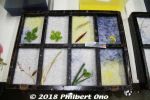
A few people even embedded leaves.
|
|
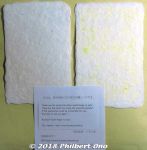
They later sent us our postcards. Mine came out okay.
|
|
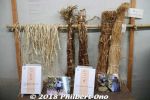
This shows how they typically hang and dry the white strips and bark strips.
|
|
|
|
|
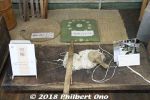
Later, it is mashed/beaten in a stone mortar.
|
|
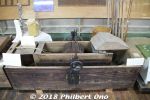
Then it goes through a mechanical beater for 10 min. to become a wet, fibrous mass. They also make and add a plant-based adhesive. Here's a good video (in Japanese) showing how they do it (the woman we saw in the river also appears in this video): https://youtu.be/-3ws9DlPVHo?t=425
|
|
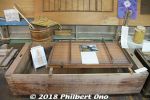
The vat and mold to make paper.
|
|

Kami-suki is what everyone can experience.
|
|
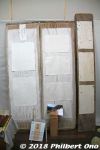
The washi shets are dried on wooden boards.
|
|
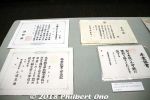
Local public schools have their kids make their diplomas with Kurotani washi.
|
|
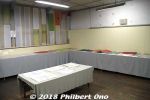
Second floor in former classrooms are exhibition rooms.
|
|
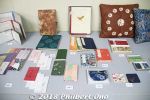
Kurotani washi has long fibers, making it very strong and durable. It has many uses such as umbrellas, shoji paper sliding doors, and packaging.
|
|
|
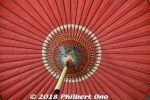
Kurotani washi can even be used for umbrellas.
|
|
|
|
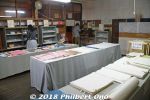
Gift shop.
|
|
|
|
|
|
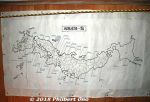
Places in Japan where washi is made.https://kurotaniwashi.kyoto
English: https://kurotaniwashi.kyoto/?page_id=450
|
|
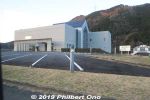
Mino Washi Museum has exhibits about washi history, washi making, and washi paper art. It also offers washi paper-making lessons. Make your own washi postcards, etc. Anybody can do it. Open 9 a.m.–5 p.m., closed Tue. Admission ¥500 (¥250 for elementary school and jr. high school). From Mino-shi Station, take a taxi. The museum is far from the train station because it needs to be near a clean river. Parking available.
|
|

Entrance to Mino Washi Museum (Mino Washi no Sato Kaikan). It was renovated in April 2017, so it looks new. There are three floors, including a basement floor.
|
|
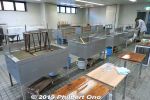
Basement floor has this paper-making workshop where you can try making your own washi paper. It can be a single sheet 33x45cm), 6 postcards, or diploma. Takes less than an hour. Fees are ¥500 to ¥800. ワークショップ - 紙すきの体験
|
|
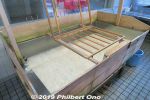
A large vat (sukifune) filled with washi fibers floating evenly in the water.
|
|
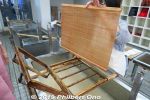
Our washi instructor taught us how to do it using a wooden mold (keta 桁) supporting a screen.
|
|
|

Dump the mold into the vat and swish it left/right and forward/back evenly.
|
|
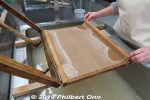
This is what happens when you don't do it right. Uneven paper.
|
|
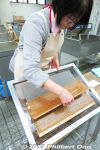
Transferring the paper sheet.
|
|
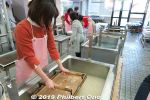
We tried making a washi sheet.
|
|
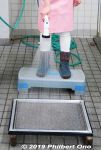
We could put a steel grating having a template design over the washi sheet and sprinkle water over it to impress the grating template on the the paper.
|
|
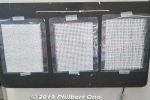
The streel grating makes these patterns on the paper. We could choose one of these.
|
|
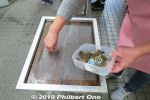
We could also put small leaves on the paper.
|
|
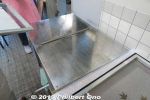
Paper vaccuum dryer. The slit sucks water from the paper.
|
|

Paper vaccuum dryer sucking water from the wet washi paper moving across the slit underneath. Vey neat.
|
|
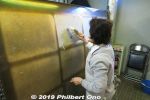
The paper is them placed on this water heater to further dry the paper. We could take home our washi after 30 min.
|
|
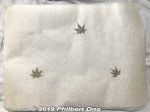
My Mino washi paper.
|
|

Washi making lessons. You can make an A4 sheet, postcards, etc.
|
|

Steps to make the washi fibers from mulberry plants, kozo, mitsumata, and ganpi. Bark is stripped and soaked in river water. Kozo is then boiled. Specks of impurities are picked off. The bark is mashed.
|
|
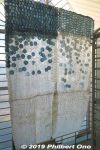
The museum has exhibition rooms and spaces to display washi artwork.
|
|
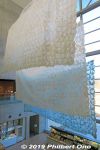
On the 1st floor below, there's a gift shop where you can buy Mino washi paper products. It's also where you can sign up for a washi papermaking lesson.
|
|
|
|
|
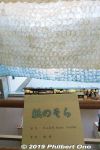
Washi artist is Akiyama Nobushige.
|
|
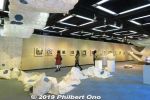
On the 2nd floor, Exhibition Room I displays washi art.
|
|
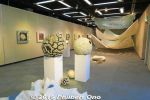
Exhibition room displaying washi art.
|
|
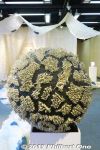
Mino Washi Museum, Gifu
|
|
|
|
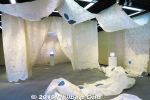
Mino Washi Museum, Gifu
|
|
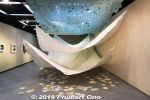
Mino Washi Museum, Gifu
|
|
|
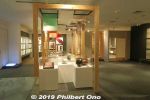
Also on the 2nd floor, Exhibition Room II displaying washi used at home and in practical and commercial products.
|
|
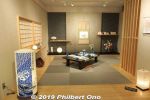
Exhibition room displaying washi used in practical and commercial products.
|
|
|
|
|
|

Japanese style
|
|

Yarn and speaker cones made of Mino washi.
|
|

About washi yarn.
|
|
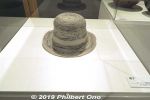
Washi hat
|
|
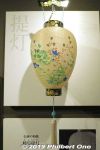
Washi paper lantern
|
|

Mechanized papermaking
|
|

The spread of paper
|
|

Paper for everyday use
|
|

Wash for various purposes
|
|
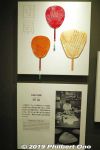
Washi uchiwa fans
|
|
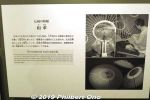
Washi umbrellas
|
|
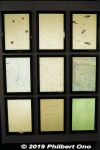
Mino washi postcards
|
|
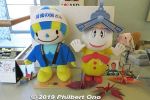
Mino mascots
|
|

General information for visitors. The museum has three floors.
|
|
|
|
|
|
|





